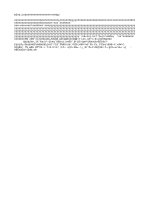Operations management by stevenson 9th student slides chapter 3
Bạn đang xem bản rút gọn của tài liệu. Xem và tải ngay bản đầy đủ của tài liệu tại đây (359.77 KB, 15 trang )
Chapter 3
Forecasting
McGraw-Hill/Irwin
Copyright © 2009 by The McGraw-Hill Companies, Inc. All Rights Reserved.
Chapter 3: Learning Objectives
• You should be able to:
– List the elements of a good forecast
– Outline the steps in the forecasting process
– Describe qualitative forecasting techniques and their advantages and
disadvantages
– Compare and contrast qualitative and quantitative approaches to forecasting
– Briefly describe averaging techniques, trend and seasonal techniques, and
regression analysis, and solve typical problems
– Describe three measures of forecast accuracy
– Describe two ways of evaluating and controlling forecasts
– Identify the major factors to consider when choosing a forecasting technique
3-2
Forecast
• Forecast – a statement about the future value
of a variable of interest
– We make forecasts about such things as weather,
demand, and resource availability
– Forecasts are an important element in making
informed decisions
3-3
An Important Input to Decision Making
• The primary goal operations and supply chain
management is to match supply to demand
– A demand forecast is essential for determining how
much supply will be needed to match demand:
• Budget preparation
• Capacity decisions (e.g., staff and equipment)
• Purchasing decisions
3-4
Forecast Uses
• Plan the system
– Generally involves long-range plans related to:
• Types of products and services to offer
• Facility and equipment levels
• Facility location
• Plan the use of the system
– Generally involves short- and medium-range plans related to:
• Inventory management
• Workforce levels
• Purchasing
• Budgeting
3-5
Elements of a Good Forecast
The forecast
• should be timely
• should be accurate
• should be reliable
• should be expressed in meaningful units
• should be in writing
• technique should be simple to understand and use
• should be cost effective
3-6
Steps in the Forecasting Process
1.
2.
3.
4.
5.
6.
Determine the purpose of the forecast
Establish a time horizon
Select a forecasting technique
Obtain, clean, and analyze appropriate data
Make the forecast
Monitor the forecast
3-7
Forecasting Approaches
• Qualitative Forecasting
– Qualitative techniques permit the inclusion of soft information such as:
• Human factors
• Personal opinions
• Hunches
– These factors are difficult, or impossible, to quantify
• Quantitative Forecasting
– Quantitative techniques involve either the projection of historical data or
the development of associative methods that attempt to use causal
variables to make a forecast
– These techniques rely on hard data
3-8
Time-Series Behaviors
3-9
Time-Series Forecasting - Averaging
• These Techniques work best when a series
tends to vary about an average
– Averaging techniques smooth variations in the data
– They can handle step changes or gradual changes in
the level of a series
– Techniques
• Moving average
• Weighted moving average
• Exponential smoothing
3-10
Simple Linear Regression
• Regression - a technique for fitting a line to a
set of data points
– Simple linear regression - the simplest form of
regression that involves a linear relationship between
two variables
• The object of simple linear regression is to obtain an equation
of a straight line that minimizes the sum of squared vertical
deviations from the line (i.e., the least squares criterion)
3-11
Monitoring the Forecast
• Tracking forecast errors and analyzing them can provide useful
insight into whether forecasts are performing satisfactorily
• Sources of forecast errors
–
–
–
–
The model may be inadequate
Irregular variations may have occurred
The forecasting technique has been incorrectly applied
Random error
• Control charts are useful for identifying the presence of nonrandom error in forecasts
• Tracking signals can be used to detect forecast bias
3-12
Choosing a Forecasting Technique
• Factors to consider
– Cost
– Accuracy
– Availability of historical data
– Availability of forecasting software
– Time needed to gather and analyze data and prepare
a forecast
– Forecast horizon
3-13
Using Forecast Information
• Reactive approach
– View forecasts as probable future demand
– React to meet that demand
• Proactive approach
– Seeks to actively influence demand
• Advertising
• Pricing
• Product/service modifications
– Generally requires either and explanatory model or a subjective
assessment of the influence on demand
3-14
Operations Strategy
• The better forecasts are, the more able organizations will be to
take advantage of future opportunities and reduce potential risks
– A worthwhile strategy is to work to improve short-term forecasts
• Accurate up-to-date information can have a significant effect on
forecast accuracy:
– Prices
– Demand
– Other important variables
– Reduce the time horizon forecasts have to cover
– Sharing forecasts or demand data through the
supply chain can improve forecast quality
3-15









